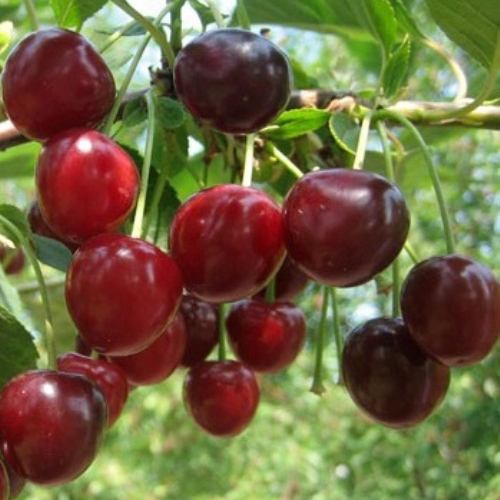Cherry variety Griot Moscow
Cherry novelties are certainly good, since selection does not stand still, and varieties that have appeared in recent years have improved characteristics. But how they will behave under adverse weather conditions is still a question. But the old varieties, tested by time and the vagaries of the weather, deserve a place in the garden. These include Griot of Moscow, which has earned respect from gardeners in the Moscow region. The author of the cherry was the famous scientist H.K. Enikeev. It was he who managed to isolate and select a clone of Griot Ostheim. In the State Register of Breeding Achievements of Russia, the then novelty was introduced in 1959 and received admission for cultivation in the Central region (Moscow, Tula, Bryansk, Smolensk, Vladimir, Ivanovo, Kaluga and Ryazan regions). True, the application for carrying out the variety testing was filed later, in 1963. The applicant and originator of the variety is the All-Russian Institute of Selection and Technology of Horticulture and Nursery.

Description
The culture belongs to the group of bushy cherries. Growth vigor is average, an adult tree reaches a height of 2.5, sometimes 3.0 meters. The drooping thin branches form a dense crown of a spherical or wide-round shape. The bark of the shoots is brownish-brown, with a grayish bloom. Leaves are medium in size, obovate, with a double-serrated edge, an elongated pointed tip and a wedge-shaped base. The leaf blade is thin, with a matte surface, bright green. The petiole is of medium length and width. Fruiting of the variety occurs mainly on a one-year growth.
Drupes of Moscow Griot are rounded, sometimes slightly flattened. Average size, weight 3.0 - 3.5 grams. The skin is thin, delicate, glossy. At the stage of consumer ripeness, the berries acquire a dark red or black-red color with barely noticeable subcutaneous dots. The pulp is dark red, very juicy, tender, medium-dense. The taste is sweet and sour, rather for an amateur. The juice is dark red. The stone is light brown, round or slightly oval, of medium size, easily separated from the pulp. The peduncle is long and thin. At the point of attachment to the drupe, it may have a slight anthocyanin coloration. The separation from the fetus is wet. 100 grams of pulp contains: dry matter 13%, sugars 10.6%, acids 1.5%.
Characteristics
- Cherry has good maturity. The tree forms its first harvest 3-4 years after planting;
- flowering occurs in the second decade of May, so return frosts are not a big problem;
- in terms of ripening, the variety is mid-season. The berries ripen in mid-July;
- the variety is valued for its stable and annual fruiting ability;
- Moscow's Griot does not shine with high yields, but every year a small plant brings about 8.6 kg per tree, which is an indicator of average productivity. From one hectare, 6.0 - 8.0 tons are obtained. In the most favorable years, the yield was 15.5 kg per tree;
- in terms of winter hardiness, the variety is much more hardy when compared with the parent Ostheim Griot. But in severe winters, this indicator is still insufficient, since freezing is observed not only of the fruit buds, but also of the vegetative parts;
- immunity is not high enough. From the parent, our hero passed on the average resistance to coccomycosis, noticeable lesions can be noted in unfavorable years. The resistance to moniliosis is even lower;
- transportability and keeping quality are low. Cherries are very juicy, and besides, the separation is wet;
- the way of using the crop is universal.Berries in their natural form are good for health, however, the taste is somewhat sour. Therefore, many classify the variety not as a table variety, but rather as a technical variety. Indeed, the harvest is very suitable for processing.
Pollinators
The Moscow Griot, unfortunately, is self-fruitless. To help a variety form a full harvest and improve the quality of its berries, the garden needs the right pollinators to bloom with the variety at the same time. These include the Pink flask, Lyubskaya and Vladimirskaya... In some sources, there is information that the described species is itself a good pollinator.
Agrotechnics
In order for the plant to please with yield and longevity, you need to know some of the nuances of planting and care. Cherries are planted in spring. The distance to the neighboring plant is 2 meters, the row spacing is 2.5 meters. Our heroine loves the sun, so choose the most illuminated site. The requirements for the soils are as follows: acidity must be neutral; in terms of texture, the soil is preferable loose, permeable, nutritious. Waterlogged soils are not suitable, so make sure that the water table in the allotted area is below 1.5 meters from the surface. Low-lying areas and pits are not suitable for planting, it is damp and cold air accumulates there, because of which the culture will constantly hurt. Particular attention should be paid to preventive treatments, taking into account the lack of disease resistance. A feature of this cherry is the formation of a large number of shoots. On the one hand, this complicates care, but on the other hand, it allows you to quickly multiply the culture if necessary.
Griot Moscow is an excellent variety, zoned in the Central region of Russia. A reliable crop withstands cold weather well and pleases with a stable harvest. All this makes the plant popular and quite widespread in Moscow and the Moscow region. The tree is small, convenient for care and harvesting, in addition, it will help to pollinate such well-known varieties as Vladimirskaya and Lyubskaya (which can be planted to pollinate our heroine). Of course, there are disadvantages, first of all, it is insufficient resistance to moniliosis, which in wet weather can weaken a tree before the onset of the winter period. In addition, the taste of cherries is considered by many to be too sour, but berries are excellent for processing.








